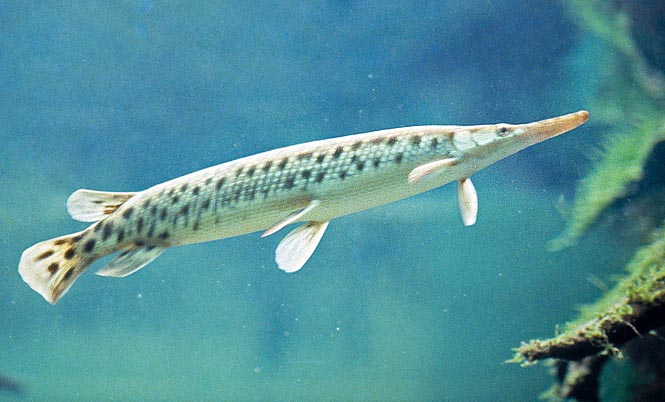Family : Lepisosteidae

Text © DrSc Giuliano Russini – Biologist Zoologist

English translation by Mario Beltramini

The Lepisosteus osseus is a living fossil, but is not an endangered species © Giuseppe Mazza
Several fossil forms have been found by the biologists (in the specific, by the ichthyopaleontologists) dating from the Permian period, Primary or Paleozoic era (299-251 million of years ago), in the Old as well as in the New World; the term “Permian”, comes from the layers of red rocks which occupy a vast area west to the Urals, in the old state of Perm, in Russia, by this period, or more precisely during its final part, corresponds to on e of the greatest mass extinctions in the history of the Planet Earth, the Permian-Triassic extinction.
Only two families of these fishes have survived till our days, without remarkable changes, in the American continental waters.
One, that of the (Amiidae), includes only one genus, the Amia, the other, that of the Lepisosteids (Lepisosteidae) has two genera: the (Lepisosteus and the Atractosteus).
They are really living fossils, like the coelacanth or the lungfishes. Like their forefathers, they have remarkably ossified skeleton, cycloidal or ganoidal scales, bilobed swim bladder and a rudimental spiral-shaped valve in the intestine.
Some taxonomical biologists consider this order as sufficiently original, so much to be able, perhaps, to form an independent subclass, inside the infraclass of the bony fishes Holostei (Holostei).
The families which are afferent to the order of the Amiiformes (Amiiformes), as aforementioned, are two, that of the (Amiidae) with only the genus (Amia) and that of the Lepisosteids (Lepisosteidae) with the genus (Lepisosteus), to which is afferent the species Lepisosteus osseus treated in this text, and, in the past, also the Lepisosteus spatula, nowadays, on the contrary, inserted in the genus (Atractosteus), with the name of Atractosteus spatula.
The Longnose gar, or Needlenose gar (Lepisosteus osseus), is afferent to the class of the Actinopterygians (Actinopterygii,) to the order of the Amiiformes (Amiiformes , other ichthyological biologists place it in the Semionotiformes), to the family of the Lepisosteids (Lepisosteidae) and to the genus (Lepisosteus).
Zoogeography
It lives in the American Great Lakes region and in the waterways of eastern USA, of Central America and along the river Mississippi, in Alabama and in Texas, as well as in the swamps of Florida, where it reaches disproportionate numbers.
It can be met also in the lakes of the Quebec, French Canada, and in the southernmost part of Ontario, English Canada.
Habitat-Ecology
This fish spends hibernating the winter, on the bottom of the waterway where it lives, staying there motionless and ceasing to feed; during the summer it is a greedy predator, it nourishes of other fishes, molluscs and crustaceans, exploiting the ability to swim very fast and to move upstream in spite of impetuous currents, hunting in ambush, opening the mouth and, with a quick lateral movement of the head, catching the prey with its sharp teeth.
Morpho-physiology
It is from a metre to a metre and a half long, has the upper part of the body greenish, dotted with more or less rounded dark spots; particularly visible in the young specimens and white belly.
The snout has a tapered tubular structure which has granted the name of longnose gar, with toothless jaw. The caudal fin is heterocercal, the anal and dorsal fins are symmetrically opposed and bent backward, the pelvic ones are placed in the mid of the body.
During the summer, especially in the southern regions, when the concentration of the O2 in water decreases remarkably, frequently surfaces putting itself on a side and by opening the mouth it swallows a good volume of air, therefore of atmospheric oxygen, which will be stored into the bilobed swim bladder, which, being connected with the pharynx, allows the respiratory gas exchange.
Ethology-Reproductive Biology
The eggs, approximately of the same size as those of the salmon, are spawned among the seaweeds in spring, from late April to June-May. During this period, the female moves towards the banks where the waters are shallower and calmer and are present aquatic plants. Once there, followed by several males, the ritual forms of struggle take place for the conquest of the female. The greenish eggs, are fecundate externally, the small larvae get out from the fecundated eggs after about 13 days, anchor they too on the aquatic plants, by means of a buccal cup, nourishing of the reserve material stocked into the yolk sac.
By mid development, seven days about, which coincides with the halving of the yolk sac, the vertebral column elongates in one of the two lobes (the upper one), of the caudal fin, rendering the same “heterocercal”; after 14 days of this type of life, the larvae are capable to carry on an independent life and to swim.
During all this time, the parents have completely ignored their progeny.
As an average, it lives 18-20 years and for the International Union for Conservation of Nature (IUCN), it is absolutely not, to date, an endangered species.
Synonyms
Esox osseus Linnaeus, 1758; Esox viridis Gmelin, 1789; Lepidosteus ayresii Duméril, 1870; Lepidosteus bison DeKay, 1842; Lepidosteus clintonii Duméril, 1870; Lepidosteus copei Duméril, 1870; Lepidosteus crassus Cope, 1865; Lepidosteus elisabeth Duméril, 1870; Lepidosteus harlani Duméril, 1870; Lepidosteus horatii Duméril, 1870; Lepidosteus lamarii Duméril, 1870; Lepidosteus leptorhynchus Girard, 1858; Lepidosteus lesueurii Duméril, 1870; Lepidosteus louisianensis Duméril, 1870; Lepidosteus milberti Duméril, 1870; Lepidosteus otarius Cope, 1865; Lepidosteus piquotianus Duméril, 1870; Lepidosteus rostratus Cuvier, 1836; Lepidosteus smithii Duméril, 1870; Lepidosteus thompsonii Duméril, 1870; Lepidosteus troostii Duméril, 1870; Lepisosteus gavial Lacepède, 1803; Lepisosteus gracilis Richardson, 1836; Lepisosteus huronensis Richardson, 1836; Lepisosteus lineatus Thompson, 1842; Lepisosteus longirostris Rafinesque, 1820; Lepisosteus oxyurus Rafinesque, 1820; Lepisosteus treculii Duméril, 1870; Macrognathus loricatus Gronow, 1854; Sarchirus vittatus Rafinesque, 1818.
→ For general information about fishes please click here.
